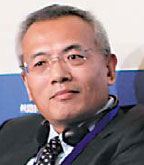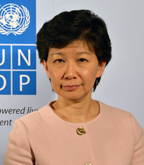What they say
Editor's note: At the two-day Silk Road Forum that began in Madrid, Spain, on Tuesday, experts and scholars from 30 countries talked about the impact of the Belt and Road Initiative on the regional development and global economy.
China will continue to engage with existing multilateral development banks while working to establish new ones, with an aim to help unleash the comparative advantages of various countries in natural resources, capital, industrial development and human resources. Infrastructure is the key to successful implementation of the initiative. As the countries along the route vary significantly in their stages of economic and social development, underinvestment in infrastructure, if not addressed, may present a major obstacle for continued economic growth.
Yang Shaolin, director general of the International Economic and Financial Cooperation Department at the Chinese Ministry of Finance

It is definitely the case that commercial banks can finance the short-term part of project finance, but we can't take the political and legal risks of a 30-year plan, which is where multinational development banks need to come into the equation. The private sector is always very enthusiastic to finance things with commercial returns, so you'll find that the private sector find it very easy to finance telecom, communication and broadband, and find it very difficult to finance water and sanitation, which are really about poverty relief and have an enormous social component.
Stuart Gulliver, group chief executive of HSBC Holdings

There are many lessons that we at European Bank for Reconstruction and Development have learned that we could share with financial institutions related to the Belt and Road Initiative. We only invest in projects that are sound banking projects because the projects need to be affordable for infrastructure users. Proper pricing of what economists call environmental externalities into the business plans matter a great deal in the long term.
Mattia Romani, managing director for country and sector economics at European Bank for Reconstruction and

Development
The Belt and Road Initiative presents unprecedented opportunities for China and the world. It especially presents enormous cooperation potential between Europe and China. Europe is technologically innovative while China is the second-largest economy in the world. There is a huge market here that requires advanced technologies, improved efficiency and environmentally friendly investments.
Wang Yanzhi, executive director of the board of directors and president of the Silk Road Fund

It is a time of great transformation in the world. Achieving sustainable development goals requires an inclusive global partnership. The Belt and Road Initiative, through building basic infrastructure, fostering connectivity, and promoting trade, cultural and people exchanges, can contribute significantly to the countries involved for “shared prosperity, peace and partnership” to build a better life for people.
We welcome the major efforts by China, including building economic corridors, setting up the Silk Road Fund and the Asian Infrastructure Investment Bank, and its strong commitments announced by the President of China at the General Assembly to scaling-up South-South Co-operation.
At United Nations Development Program, we believe the development impact of the initiative can be optimized through conjoining SDG-informed national development strategies and leveraging comparative advantages of partners to put plans into collective action. UNDP is committed to working with China to maximize that potential and to advance South-South and Triangular Cooperation for sustainable development.
Izumi Nakamitsu, assistant secretary general at UNDP

(China Daily 10/30/2015 page12)


















